A History of the County of Hampshire: Volume 4. Originally published by Victoria County History, London, 1911.
This free content was digitised by double rekeying. All rights reserved.
'Parishes: Eling', in A History of the County of Hampshire: Volume 4, ed. William Page (London, 1911), British History Online https://prod.british-history.ac.uk/vch/hants/vol4/pp546-558 [accessed 24 February 2025].
'Parishes: Eling', in A History of the County of Hampshire: Volume 4. Edited by William Page (London, 1911), British History Online, accessed February 24, 2025, https://prod.british-history.ac.uk/vch/hants/vol4/pp546-558.
"Parishes: Eling". A History of the County of Hampshire: Volume 4. Ed. William Page (London, 1911), British History Online. Web. 24 February 2025. https://prod.british-history.ac.uk/vch/hants/vol4/pp546-558.
In this section
ELING
Edlinges (xi cent.); Elinga, Elinges (xii cent.); Elinges (xiii cent.).
The ancient parish of Eling included the modern parishes of Eling, Netley Marsh, Copythorne, Colbury and Marchwood, the four latter parishes being formed from Eling in 1894. (fn. 1) The inclosure award for Eling is dated 30 November 1814. (fn. 2)
The modern parish of Eling lies on the western shores of the Southampton Water and includes Rumbridge, Totton and parts of Hounsdown and Pooksgreen. It contains 2,144 acres of land, including 10 acres of inland water, of which 507¼ acres are arable land, 947½ permanent grass and 42¼ woodland. (fn. 3) It lies in the valley of the River Test, (fn. 4) which meets Bartley Water, as it flows through the parish, in Eling channel. There is a station at Totton on the London and South Western Railway.
Totton is the most populous part of Eling on account of its saw and flour-mills, chemical manure works, brewery, and tar distilling and creosoting works. A bone-mill and soap manufactory formerly existed there, and a considerable trade, much reduced since the opening of the railway, was carried on in coal, timber and corn. There were also magazines of military stores, and a large shipbuilding establishment, now removed to Redbridge. A fair for cattle takes place at Eling on 5 July. On the banks of the Test are about 50 acres of excellent salt-marsh, over which the inhabitants of Eling enjoy rights of common, except from the second Monday after Easter until 14 August, when only seven persons may feed one horse each. It is then closed for about a month until the grass has been cut and carried. Henry I crossed to Normandy from Eling (Eilling) and King's pleas were held there in his reign. (fn. 5)
The small village of Eling lies on the road from Totton to Pooksgreen. The church stands on high ground not far from the water's edge, and near it is the vicarage with its extensive garden and fine trees. To the south is Colbury Manor, the residence of the Misses Hony, and to the north is Downs House, standing in grounds of 140 acres, the property of Mr. Archibald C. Saunders, now occupied by the Hon. Mrs. Montgomerie. There are parks at Rushington House, the seat of Mr. Vere Henry Birch Reynardson, and at Testwood House, the residence of Captain A. P. Beaumont, J.P.
Netley Marsh lies to the north-west of Eling, on low ground rising from 50 ft. in the village to 140 ft. above the ordnance datum at Tatchbury Mount (fn. 6) in the west. It includes Calmoor, Hillstreet, Woodlands and part of Ower, and contains 3,886 acres of land, of which 7 acres are covered with water, 1,269 acres are arable land, 1,831 permanent grass and 303½ woodland. (fn. 7) The village is on the high road from Fordingbridge to Southampton, and to the west of it is the Hampshire Reformatory School, opened in 1855 (fn. 8) Woodlands is south of the village, Calmoor, Hillstreet and Ower (chiefly in Copythorne) are to the north. Cadnam River and the River Blackwater pass through the north of the parish.
There are parks at Little Testwood House (Col. the Hon. Edward Arthur Palk), at Loperwood Manor (Mr. R. C. Sutherland Pearce), at Tatchbury Mount, which has been in the possession of the Timson family for several generations and is now in the possession of Mr. H. T. Timson, and at Tatchbury Manor House (Lieut.-Col. W. C. Pollard). The parish is well wooded by small copses. There is some rough common land to the east of Woodlands. The soil is heavy clay and the subsoil clay.
Copythorne is a large parish, lying low in the valleys of the Cadnam River, the Blackwater and the Bartley Water, including Bartley, Newbridge, Wigley and parts of Cadnam and Ower. It contains 5,551 acres of land with 29 acres of inland water, of which 916 acres are arable land, 1,715 acres permanent grass and 1,159½ acres woodland. (fn. 9)
The village is on the high road to Romsey, and to the north of it is Copythorne Common; parts of Cadnam Common and Furzley Common are also in the parish, and Shelly Common, a wide tract of rough common, lies on the north side of the Salisbury and Southampton high road. There are large tracts of woodland in the south, west and north of the parish, and there are parks at Paultons (Captain Roger C. H. Sloane-Stanley), Bartley Lodge (Major F. B. Dalrymple), Beechwood (Col. Charles G. Heathcote, J.P.), and Goldenhays (Mrs. Howard). The soil is clay.
There are tumuli at Barrow Hill, east of the village of Copythorne, and a supposed Roman camp on Half-Moon Common.
The parish of Colbury, including part of Hounsdown, lies low in the valley between the Beaulieu River and Bartley Water. It contains 5,472 acres of land, of which 4 acres are covered by water, 287¼ acres are arable land and 930½ permanent grass, while the computed 4,763 acres of woods and plantations extend into the surrounding parishes and the New Forest. (fn. 10) The New Forest Union Workhouse is at Ashurst, in this parish near the Lyndhurst Road Station, on the London and South Western Railway.
The village lies along Deerleap Lane, which, opposite Langley Manor, branches south from the Lymington and Southampton high road. Hounsdown is about a quarter of a mile north on this high road.
Marchwood includes that part of the ancient parish of Eling which lies low (fn. 11) at the mouth of the River Test and south-east of the town of Eling. It contains 1,599 acres of land, of which 4 acres are covered with water, 430½ acres are arable land, 829¾ are pasture land and 181 are woodland. (fn. 12) The village lies along the road from Eling to Dibden. There are Government powder magazines and Metropolitan Police barracks.
Byams House, north-east of the village, was rebuilt in 1878, and was for many years the seat of Mr. William Gascoigne Roy, J.P., to whose family it had belonged for over a century. It now belongs to Major John H. Grime Lloyd. Marchwood Park, formerly the property of the Holloway family, but now belonging to Mrs. Ross Porter, is in the south of the parish, and lies partly in Dibden. The soil is clay and sand.
Place-names that occur are:—Rudbrugstrete, Cokkescros, Holelane, Hylle Pat Asshe, Joyes Ende, Bulslade Diche (fn. 13) (xv cent.); Mershegate, Regge, Colfoxe, Ligginham Mede, (fn. 14) Lanyngton Cops (fn. 15) (xvi cent.).
Manors
The manor of ELING was held at the time of the Domesday Survey by the king in demesne. In the time of King Edward it had rendered half a day's ferm, and its hidage was not known. Belonging to Eling were two berwicks in the Isle of Wight and three elsewhere, but when Hugh de Port received the manor the two berwicks in the Isle of Wight were separated from it and were held by Earl William of Hereford. Sixteen villein tenements, three bordar tenements and a considerable amount of woodland had been taken from the manor and put into the New Forest. (fn. 16) With the exception of a grant for life to Gervaise de Southampton, who founded God's House, Southampton, about 1193, (fn. 17) the manor apparently remained with the Crown (fn. 18) until King John early in his reign granted it to Emma de Clere or de Staunton, to hold for the service of a tenth part of a knight's fee. (fn. 19) Emma's daughter Cecily married Henry Husee, who, probably for entry without licence, forfeited the manor, which was ordered to be restored to him in 1217. (fn. 20) However, this was evidently not done until 1221, when another order to the same effect was given to the Sheriff of Hampshire. (fn. 21) About 1227, by covenant with the owners of the neighbouring manors of Testwood, Totton and Winsor as to common of pasture at Eling, Henry and Cecily obtained a place called Parlesham and woodland and pasture in Siggesford and Parlesham and 60 acres of land to the east and north of Neceswude with the right to inclose and reduce it to arable. (fn. 22) Cecily Husee died about 1235–6, and was succeeded by her son Matthew. (fn. 23) In 1240–1 Maud Husee, possibly widow of Matthew, conveyed a carucate of land in Eling to John de Gatesden, who was to hold it of Maud and her heirs for the service of half a knight's fee. (fn. 24) Whatever the relationship between Matthew and Maud Husee, we find that the latter afterwards became the wife of Ralph Chenduit, and together with him in 1242–3 settled the manor upon John de Gatesden and his heirs, with reversion in default to themselves and their heirs. (fn. 25)
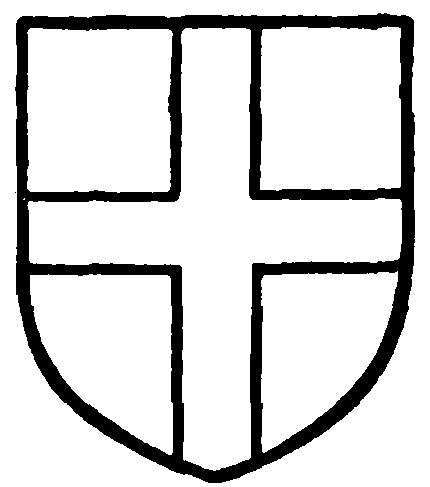
Husee (the old coat). Or a cross vert.
Margaret, daughter and heir of John de Gatesden, married John de Camoys, (fn. 26) and in 1267 Ralph de Camoys, son and heir of John, conveyed all his right in Eling to Robert Waleran. (fn. 27) The latter, before his death about 1273, (fn. 28) had already conveyed Eling to Alan de Plukenet, (fn. 29) but possibly owing to some flaw in the proceedings by which Ralph de Camoys had conveyed his right to Robert Waleran in 1267, Margaret wife of John Camoys brought a successful suit against Alan Plukenet for the manor in 1297–8. (fn. 30) Moreover, on her death in 1310–11, the king took fealty for the manor of her son Ralph, (fn. 31) who in 1319–20 obtained a grant of free warren in the manor, (fn. 32) and settled it in 1323 upon himself and his wife Elizabeth. (fn. 33) However, in that year, for some unknown reason, the manor reverted to the Husees, who, from the time when Eling was alienated to John de Gatesden in 1240–1, (fn. 34) had retained their right in the overlordship and the reversion of the manor. (fn. 35) In 1345 Henry Husee, great-grandson of the Matthew Husee mentioned above, (fn. 36) granted it for life to Hugh de Camoys, the king's yeoman, (fn. 37) possibly son of Ralph, son of John and Margaret. (fn. 38) This Hugh obtained a grant of free warren in the manor in 1367–8, (fn. 39) and in 1372–3 Sir Henry Husee, grandson of Henry the grantor of the manor, gave the reversion after the death of Hugh de Camoys to William of Wykeham, Bishop of Winchester. (fn. 40) Hugh was still in possession in 1380, (fn. 41) but had apparently died before 1385, in which year William of Wykeham granted the manor to the Warden and scholars of Winchester College, (fn. 42) who are the lords of the manor at the present day.
An estate at Eling known as the manor of ELING was held by a family taking their name from the estate by the serjeanty of being bailiff itinerant in the hundreds of East and West Medina and Freshwater in the Isle of Wight, and in the hundreds of Christchurch, Ringwood, Fordingbridge, Redbridge and the New Forest. (fn. 43) It is not known how this family obtained the estate, but Edmund de Eling occurs in 1168–9, (fn. 44) and in 1228 the Sheriff of Hampshire was commanded to give seisin to Richard de Eling of 4 acres of land and a garden in Eling. (fn. 45) Richard was succeeded before 1255–6 by Roger de Eling, who still held the manor in 1279–80. (fn. 46) Richard de Eling died in 1345 holding the estate, which was in the same year delivered to his son John, (fn. 47) who died seised in 1349–50. (fn. 48) On the death of his son and heir John (fn. 49) in 1362–3 the manor was divided between his sisters, Emma wife of John Prior and Aubrey wife of John Pyk, and Alice daughter of his third sister Maud. (fn. 50) The further descent of this manor has not been traced. Probably with its division between the three co-heirs any manorial rights which had belonged to it fell into abeyance.
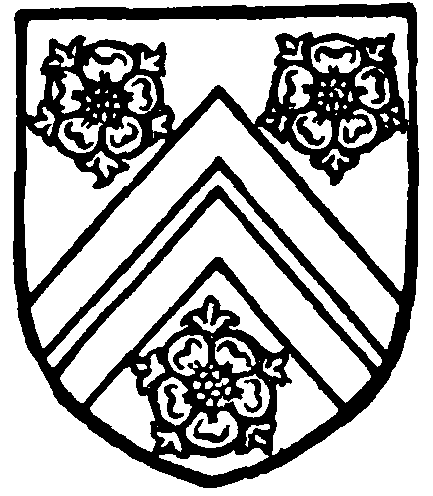
Winchester College. Argent two cheverons sable between three roses gules.
The manor of RUMBRIDGE (Rumbrigge, Rombrigg, xiv cent.) or RUSHINGTON probably formed a part of Eling and was in the hands of the Kings of England until 1159, when it was granted to Cobb the Smith. (fn. 51) The estate was held for the service of providing either 50 or 100 barbed arrows when the king should come beyond the bridge of Redbridge towards the New Forest, the number of arrows varying in different inquisitions. (fn. 52) Cobb, or descendants of the same name, held the estate until 1201–2. (fn. 53) In 1212–17 the estate is returned as held by the heir of Cobb the Smith (faber), (fn. 54) and this heir was probably Herbert the Smith, to whom the Sheriff of Hants was commanded to restore 12½ acres of meadow in Eling in 1228. (fn. 55) In the Testa de Nevill it is stated that the serjeanty of Robert Baldet in 'Redbrugh,' for which he paid annually to the Exchequer 100 barbed arrows, was alienated in part: that is to say, 2 virgates were held of Roger by Herbert son of Herbert and Adam de Redburgh for a rent of 5s. a year. (fn. 56) John Baldet died in 1256–7 holding a hide of land in Hampshire for the service of 100 barbed arrows, leaving Elias his son and heir, (fn. 57) a minor, whose custody was granted in 1257 to Richard Esturmy. (fn. 58) In 1316 Elias was holding the vills of 'Brykemerston,' (fn. 59) Netley, Berkley, Winsor, Tatchbury, Rumbridge and Newton. (fn. 60) He died in 1320–1, leaving a son and heir Philip, (fn. 61) who granted the estate to Stephen Baldet, or Baudet, probably a brother or an uncle, and his wife Ursula, and their heirs de se, with reversion in default to Philip and his heirs. (fn. 62) Stephen died in 1362, leaving a daughter Christine, (fn. 63) but she died without issue in 1367, and under the above grant the manor passed to John Baldet, son and heir of Robert, another brother of Philip. (fn. 64) John died in 1443 holding the manor (fn. 65) of Rumbridge, which, it is stated, was granted to a certain Philip Baldet, John's ancestor, 'by the name of 24s. rent with the appurtenances.' (fn. 66) John's heir was his daughter Ellen, (fn. 67) who married William Aldryche and died holding the manor in 1461. (fn. 68) Her heir may have been Katherine wife of William Fynemark, for in 1472–3 William and Katherine conveyed five messuages and 24 acres of land in Totton and Rumbridge to Lewis Aynes. (fn. 69)
John Canterton died in 1473–4 holding land in Rumbridge and elsewhere which had been settled on him and his wife Alice, who survived him. (fn. 70) The manor remained in the Canterton family (fn. 71) until 1577, when William Canterton and John his son sold the site of the manor to Richard Bacon. (fn. 72) John Bacon and his wife Anne sold the manor in 1602 to Thomas Edmonds, (fn. 73) of whom it was purchased in 1626 by Robert Guye. (fn. 74) In 1638 West Fashion died seised of the manor, leaving as his heir his nephew Thomas son of George Fashion. (fn. 75) The manor passed evidently in the same way as Stone in Fawley to William Bulkly and his wife Mary, who sold it in 1704–5 to Samuel Mason. (fn. 76) In 1733 it was purchased of William Olding and his wife Elizabeth by Henry Rositer. (fn. 77)
Mr. Walter Lynne resided at Rushington Manor in 1859, (fn. 78) and Edward Birch Reynardson, who purchased the estate about 1860, (fn. 79) died in 1896, leaving a son, Vere Henry, the present owner of Rushington Manor. (fn. 80)
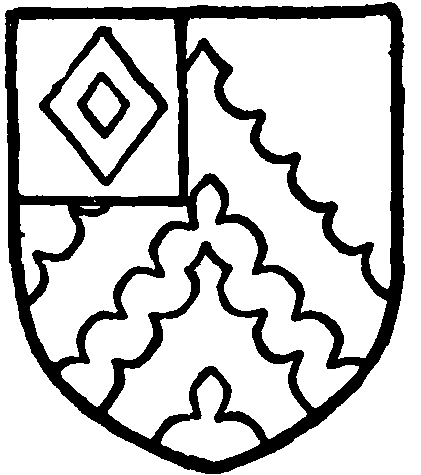
Reynardson. Or two cheverons engrailed gules and a quarter gules with a voided lozenge argent therein.
Two estates mentioned in the Domesday Survey under the name Lesteorde, or Lestred, are probably to be identified with the modern TESTWOOD (Terstwude, Therstwode, xiii cent.). One lay in Bovre (New Forest) Hundred and had been held in the time of King Edward in parage by two allodial owners. At the Conquest it passed to Earl Roger of Shrewsbury, and was counted in the New Forest, except for a quarter of a virgate which was held of the earl by a certain man who had there three bordars. (fn. 81) The second estate was in the hundred of Red bridge, and was held under the Bishop of Bayeux by Hugh de Port, of whom it was held by a certain Hugh. In the time of King Edward it had been held of the king by Alsi. (fn. 82)
Land at Testwood was acquired during the 13th century by the family of Testwood. (fn. 83) In 1227–8 Richard de Testwood, who was in possession of the manor, made a composition with Henry Husee, lord of the manor of Eling, as to common right at Eling, (fn. 84) and eight years later Walter de Bruge gave 5 acres of land in Testwood and Totton to Simon de Testwood. (fn. 85)
The manor was held of the Abbess of Romsey at a fee farm of £6 10s. 6d., (fn. 86) and was so held until the Dissolution. (fn. 87)
Richard de Testwood settled the manor in 1317–18 upon himself for life, with remainder to his son William and Elizabeth his wife and their issue. (fn. 88) William, who is called the son of Katherine de Testwood, was in possession of land at Testwood in 1329, (fn. 89) and in 1358–9 John son of William de Testwood sold the manor of Testwood to Sir Thomas West. (fn. 90) The manor then continued like Oakhanger and Newton Valence (fn. 91) (q.v.) in the West family, remaining in the family after these two manors had been sold and passing on the death of Sir Thomas West in 1622 to his grandson and heir Thomas Leigh. (fn. 92) The latter was succeeded in 1640–1 by his son Philip, (fn. 93) but Testwood was mortgaged in 1691 by Edward Leigh, probably heir of Philip, to John Lord Stawell Baron of Somerton, who soon obtained full possession of the manor. (fn. 94) It was sold by the trustees of Lord Stawell in 1695 as the manor and manors of Testwood and Ridge to Gilbert Serle, a merchant of Leghorn, (fn. 95) and it subsequently passed like Weston Corbett (q.v.) (fn. 96) to Sir William Oglander. (fn. 97) The manor is last mentioned in 1830, (fn. 98) but all manorial rights have long since lapsed.
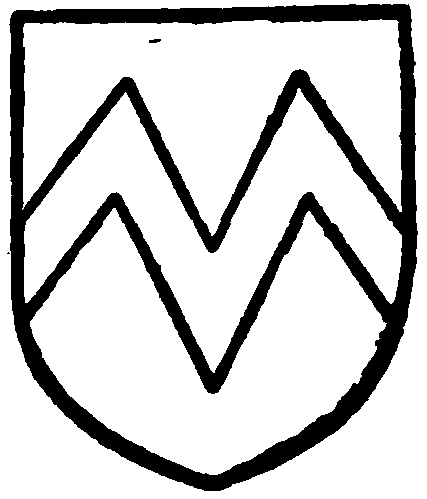
West, Lord De La Warr. Argent a fesse dancetty sable.
Testwood House was in 1848 the seat of Mrs. Sturges Bourne, and passed from her to Miss Ann Sturges Bourne, her daughter. (fn. 99) It subsequently went to Lieut.-Col. Bruce, of whom it was purchased in February 1894 by Captain A. P. Beaumont, J.P., the present owner. (fn. 100)
At the time of the Domesday Survey, as in the time of King Edward, Agemund held half a hide of the king in TOTTON. (fn. 101) (Totintone, xi cent.; Cotintone, xiii cent.) which was possibly identical with the estate confirmed by Henry III to his newlyfounded abbey at Netley in 1251. (fn. 102) The abbot held Totton, with land at Testwood, of the tenantin-chief, William de Hampton, for the service of a sixth part of a knight's fee, (fn. 103) and claimed assize of bread and ale and immunity from suit at the hundred of Redbridge. (fn. 104) In 1338 the abbot and convent obtained licence to grant lands and fisheries in Totton and Testwood to Roger de Petersfield and Henry Deverel of Netley (Lettele) for a rent of £40, (fn. 105) and in 1346 were said to be holding the manor in frank almoign for the fifth part of a knight's fee. (fn. 106)
Totton remained with the abbey until the Dissolution, (fn. 107) and was granted in 1546 to John Bellowe and John Broxholme. (fn. 108) They sold it on the following day to Richard Marden, (fn. 109) who died in 1552. His nephew and heir, Richard Marden, (fn. 110) sold the manor in 1567 to Chideock Paulet of Odiham, (fn. 111) whose son William succeeded his father in 1574, (fn. 112) and died in 1595–6, leaving a son and heir William. (fn. 113)
In June 1660 William Paulet, son of the last named William, conveyed the whole manor of Totton, except the farm and lands called Little Testwood, to James Betts of London and his heirs and assigns. (fn. 114) The descent of the manor after this time is not clear, but it is probable that the estate which passed to the Betts family then became known as the manor of TOTTON LOPERWOOD, and later as LOPERWOOD only, while Little Testwood alone remained to the Paulet family. Even so the history of Totton Loperwood is a blank throughout the 18th century, but in 1812–13 it was sold by George Jackson and Cordelia his wife to John Whishaw. (fn. 115) From Whishaw it was presumably purchased by John Taylor, who sold to Henry Timson of Tatchbury Mount (q.v.). The latter, about 1860, sold to Henry Stanley and Robert Pearce, whose son Robert Charles Sutherland Pearce is the present owner. (fn. 116) The house is still known as Loperwood Manor, but all manorial rights have long ceased, (fn. 117) and the estate now owned by Mr. Pearce is much smaller than the original Totton Loperwood, since Mr. Timson retained much of the land when he sold to Mr. Pearce's father in 1860. (fn. 118)
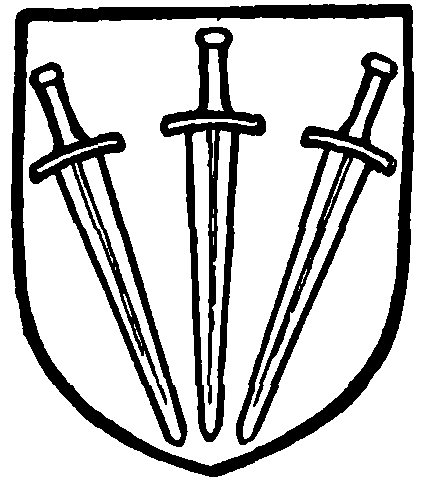
Paulet. Sable three swords set file-wise argent with their hilts or.
Little Testwood Farm and lands meanwhile remained to the Paulets from the original manor of Totton. Thus William fifth son of Norton Paulet (1681–1741) of Amport was called of Little Testwood, and on his death unmarried in 1772 he left his estates by will to his brother George, with remainder to Henry second son of George. (fn. 119)
Sir Henry Charles Paulet, son of the last-mentioned Henry, was owner and occupier of Little Testwood House in the early 19th century. He was created a baronet in 1836 and died unmarried in December 1886. (fn. 120) Little Testwood House then became the residence of Col. the Hon. Edward Arthur Palk, the present occupier.
Land in Testwood and Totton, later known as the manor of TOTTON, was held for the serjeanty of finding one servant with a hauberk in time of war in England for forty days. (fn. 121) It was evidently closely connected with the estates at Bisterne and Minstead held by the same serjeanty, and may possibly, therefore, be identified with ' Hangre ' in the hundred of Redbridge, which, like Bisterne and Minstead, was held before the Conquest by Godric Mal, and at the time of the Survey by his sons. (fn. 122) At the end of the 12th century these sons were represented by Hugh de Ivez and Robert Fitz Ulf, (fn. 123) and the land at Totton, which Hugh and Robert held, (fn. 124) passed with and merged into the manor of Minstead (q.v.).
A hide and a half of land in TATCHBURY (Tachburi, x cent.; Taceberie, Teocreberie, xi cent.; Tacheberia, xii cent.; Tachebury, xv and xvi cent.) and Slackstead was given to the abbey of Hyde on its foundation in 903 by Edward the Elder. (fn. 125) Another half hide, (fn. 126) which he had held of King Edward the Confessor in parage, was also given to the abbey by Ezi the sheriff between 1066 and 1086. (fn. 127) A further entry in the Domesday Survey under ' the lands in the New Forest and round about it' states that 2 hides at Tatchbury in Redbridge Hundred had been held by Bolle and Ulviet, but had been put into the New Forest before 1086. (fn. 128) Possibly Bolle and Ulviet had been tenants under Hyde Abbey, and the 2 hides held by them included the whole of the abbatial estate.

Hyde Abbey. Argent a lion sable and a chief sable with two keys argent set upright therein having their bows interlaced.
The abbot and convent evidently held the manor in demesne from the 12th to the 13 th century, when Abbot Walter (1222–48) granted it to Laurence Agneil and his wife Maud, daughter of Alan de Wudfold, and to Richard de Langley and John his son to hold of the abbot and his successors for a yearly rent of 20s. (fn. 129) A rent of 20s. from Litchfield and Tatchbury was included in the estates of the abbey at the Dissolution. (fn. 130)
Another estate in Tatchbury was held by Henry Husee and Cicely his wife, who in 1227 granted two messuages and 40 acres of land in Eling to Nicholas de Tachbury and Rose his wife for their lives, with reversion to the donors. (fn. 131) This was probably the nucleus of the later manor which was held in 1316 by Elias Baldet, (fn. 132) and of which John Romsey died seised in 1494, holding of the warden of Winchester College. (fn. 133)
The manor passed from John Romsey to his son John, (fn. 134) who died in 1503, leaving a son and heir William. (fn. 135) Thomas Dixe and Radigund his wife, who seems to have been the heiress of William Romsey, (fn. 136) sold the manor in 1559 to Richard Dowce. (fn. 137) The latter sold it in 1600–1 to John Grindham, (fn. 138) who left it by his will dated 1615 (fn. 139) to John Oviatt in tail male with remainder to his brothers William, Edward, Thomas and Henry. (fn. 140) John Oviatt died without issue male in 1617, and the manor passed under the will to his brother William. (fn. 141) It remained in the family of Oviatt (fn. 142) until 1758, when William Oviatt conveyed it to George Glasse. (fn. 143) By 1786–7 the manor had passed to Richard Wake and his wife Charlotte, (fn. 144) and it remained in the family of Wake until the latter half of the 19th century, being in 1859 the property of George Anthony Wake, who resided at Tatchbury Old Manor. (fn. 145) It passed from him before 1875 to Courtenay Freeman Wilson, who sold it some years later to Lieut.-Col. W. C. Pollard, the present owner and occupier of the house.
A hide of land in OWER (Ure,Ora, viii cent.; Hore, xi cent.; Overe, xiii cent.; Oure, xiv cent.; Paultons, xvi cent, et seq.) belonged at the time of the Domesday Survey to the Abbot of Glastonbury, under whom it was held by Gislebert de Bretville, as Elsi had held it of the abbot. (fn. 146) According to the Glastonbury annals a certain abbess called Begu, or Buggu, gave 3 hides at 'Ora' to Abbot Etfrid, who succeeded about 719, and her grant was confirmed by Ine, king of the West Saxons, while in 745 Cuthred, king of the West Saxons, gave to Abbot Tumbert (or Cumbert) 3 hides at 'Ure.' (fn. 147) Probably both these grants refer to Ower in Eling, as the Abbots of Glastonbury do not seem to have held any other estate of that name.
Abbot Herlwin (1102–20) sold several manors, including Ower, to a favourite, Sir Robert Cotel, and at Herlwin's death in 1120 Sir Robert took possession of the manor, which was claimed after his death by his wife and children. Abbot Siegfrid, Herlwin's successor, disputed the Cotels' claim to this and other manors, but it was not till the time of Henry de Blois, the successor of Siegfrid, that the matter was settled in favour of the abbey and the decision confirmed by Pope Lucius II in 1144. (fn. 148) In 1219, in accordance with an award for the settlement of a dispute between the Bishop of Bath and the Abbot of Glastonbury, Camerton, in Somerset, with which Ower was closely connected, was assigned to the Bishop of Bath, (fn. 149) and hence in 1280 Ower also was said to be held of the Bishop of Bath, (fn. 150) and the Bishops of Bath were overlords as late at least as 1491, after which date it seems to have been held of the lords of the manor of Camerton. (fn. 151)
The Cotels had continued to hold the manor of the Abbot of Glastonbury after the decision as to his overlordship. Thus Richard Cotel was in 1166 a tenant under the abbot of 20 librates of land which had belonged to the demesne and had been assigned to the table of the monks, but did no service for it, (fn. 152) and it remained in his family (fn. 153) until the death of Ellis Cotel (fn. 154) in 1337, leaving as his heir a daughter Edith wife of Oliver de Dynham. (fn. 155) However, Ower did not pass to the Dynhams, but had evidently been settled in 1323–4, in the same way as Lake and Oare in Wiltshire, upon John de Palton and his wife Joan, (fn. 156) for Giles de Palton was holding the manor in 1346. (fn. 157) This Giles may have been a brother of Robert son of Sir John and Joan Palton, who was succeeded by his sons Robert and William Palton in succession. (fn. 158) Robert, the elder son, died without issue in 1400, (fn. 159) and his brother and successor William granted the manor in 1404–5 to Richard Lord Seymour, Elizabeth wife of William Botreaux and others (fn. 160); but this conveyance was apparently made for the purpose of some settlement. William died in 1450, but he had apparently sold Ower before his death, since it does not appear among his lands, (fn. 161) and is next mentioned in 1491, when, in the inquisition on the death of Sir Richard Darell, he is said to have given it in frank marriage with his daughter Margaret to Sir James Lord Audley. (fn. 162) Sir James forfeited all his estates in 1497, (fn. 163) but they were restored to his son John in 1512. (fn. 164) He sold the manor, then known as PALTONS, to Henry VIII, and it was granted by Edward VI in 1547 to William Lord St. John, (fn. 165) from whom it passed in 1572 to his third son, Lord Chideock Paulet. (fn. 166) He died in 1574, when the manor passed to his son William, (fn. 167) who was succeeded in 1595–6 by William his son and heir, (fn. 168) on whose death about 1641 Paltons passed to his son William Paulet. (fn. 169) It was sold by William Paulet in 1646 as 'all that capital messuage called Paltons which is or lately was parcel of the manor or manors of Wade and Owre' to William Stanley, (fn. 170) but from this sale was excepted some part of the manor of Ower, then apparently annexed to Wade, the further descent of which will be found under Wade (q.v.). Paltons or Paultons, as it was called later, had become the capital messuage of Wigley Manor, (fn. 171) so that the manor of Ower was practically non-existent.
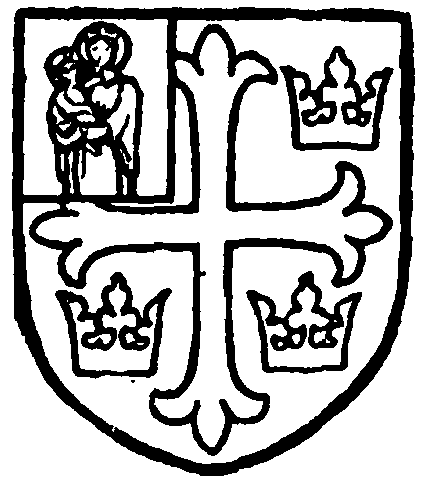
Glastonbury Abbey. Vert a cross paty argent between four crowns or and a quarter argent with Our Lady and the Child in their proper colours therein.
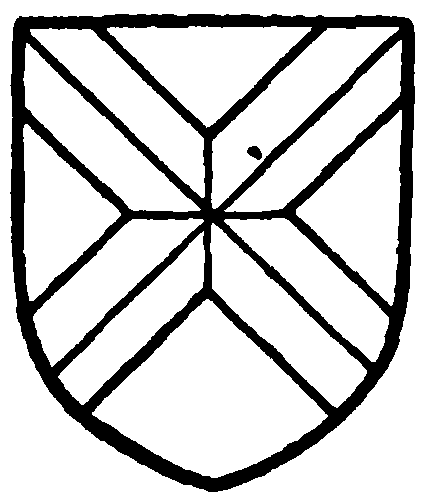
See of Bath. Azure a saltire quarterly saltirewise or and argent.

Cotel. Or a bend gules.
George Stanley, the son and successor of William, (fn. 172) died in 1733 and was succeeded by his son Hans, who died unmarried in 1780. The Paultons estate passed, subject to the lives of his two sisters, Anne Lady Mendip and Mrs. Sarah D'Oyley, to his cousin, Hans Sloane, of South Stoneham, (fn. 173) who assumed the name SloaneStanley in 1821. (fn. 174) He was succeeded by his son William, on whose death in 1860 his son William Hans succeeded to the estate. It passed from him in 1879 to his son Hans, on whose death in 1888 he was succeeded by his son Roger Cyril Hans SloaneStanley, the present owner of the estate.
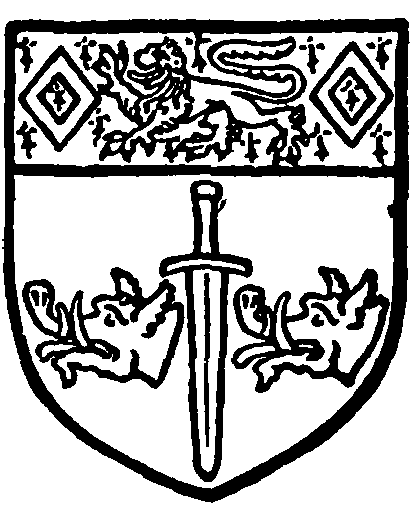
Sloane. Gules a sword argent palewise with its hilt and pommel or between two boars' heads or cut off at the neck and a chief ermine with a lion passant gules between two voided lozenges sable therein.
The house is in a park of 230 acres, laid out in the latter part of the 18th century by Welbore Ellis, the first Lord Mendip, and containing a lake of about 20 acres.
The manor of COLBURY (Coldbury, xviii cent.) was given to the Abbot of Beaulieu by Robert de Punchardon, as all the land which he held in the parish of Eling with the homage and service of Herbert de Bury for his tenement in Colbury, with a rent of 2s. which Herbert paid for his tenement. (fn. 175) This gift was confirmed by the king in 1317, (fn. 176) and was probably made after 1229 when Robert was dealing with land at Eling. (fn. 177) A grant of free warren in the manor was made in 1359–60 to the Abbot and convent of Beaulieu. (fn. 178) Successive abbots remained in possession of the manor (fn. 179) until the surrender of the abbey in April 1538, (fn. 180) when it passed to the Crown. It was granted in 1544. to Thomas Hopson, (fn. 181) of whom it was purchased in the same year by John Mill and his son John. (fn. 182) The elder John died in 1551 (fn. 183) and the younger John was succeeded by his son Lewknor. (fn. 184) He died in November 1587, and his son Lewknor died in the following month, leaving John his brother and heir. (fn. 185) John was created a baronet in 1619, (fn. 186) and the manor descended with the baronetcy until the death of the last baronet in 1835. (fn. 187) It then passed in the same way as Nursling (q.v.) to Mrs. Vaudrey Barker-Mill.

Beaulieu Abbey. Gules a royal crown enfiled with a crozier or and a border sable billety or.
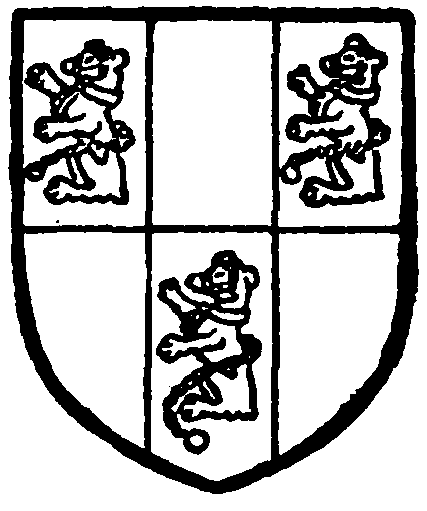
Mill, baronet. Six pieces argent and sable with three bears sable having muzzles and chains or.
Colbury Manor House was at one time the seat of the Vaudreys, but has for manyyears been occupied by the Misses Hony.
The first mention of the manor of NEWTON BURY (Bury, xiv cent.) occurs in 1228, when the Sheriff of Hampshire was ordered to restore seisin of his land in Eling to Adam de Bruge. (fn. 188) Walter de Bruge conveyed certain lands in Testwood and Totton to Simon de Testwood in 1235–6, (fn. 189) and in 1255–6 Edmund de Bruge (fn. 190) granted Adam de Bruge a messuage and 15 acres of land in Testwood, with the exception of certain land which had formerly belonged to Peter de Krockere, to be held by Adam of Edmund, with reversion to Edmund in default of the issue of Adam. (fn. 191) The manor (fn. 192) then followed the same descent as Nursling Beaufo (q.v.) (fn. 193) until the death of John Mill in 1551, when it passed with Colbury to his son John and to his grandson Lewknor. Its subsequent descent has been identical with that of Colbury (fn. 194) (q.v.).
The manor occurs in a deed of the 13 th century as the 'manor of Eling called Burylond.' (fn. 195) The only mention which occurs of the tenure of this manor (now represented by Bury Farm) is in 1493–4, when it was held of the king in socage. (fn. 196) It has been stated that it was held by an ancient grant from the Crown by the tenure of presenting the sovereign with a pair of white greyhounds in silver couples whenever he should enter the New Forest, and that this custom was observed in 1789, when the Rev. Sir Charles Mill presented the king with two greyhounds on the occasion of a royal visit to Lyndhurst, (fn. 197) but there seems to be no authority for the tradition. The manorial rights in connexion with Newton Bury seem to have lapsed before 1714 and to have become merged with those of Colbury, for the estate then comprised 'a messuage called Newton-bury' in Colbury. (fn. 198)
Bury House, as it was called in 1848, was then occupied by Mrs. W. H. Ashurst, widow of Sir Chas. Mill, but later was converted into a farm-house.
The manor of DURLEY (Derleie, xi cent.; Durle, xiv cent.) was held before the Conquest by Saulf of King Edward in parage. At the time of the Survey it was held of Edmund Fitz Payn by Hugh. (fn. 199) The manor apparently afterwards passed to the king, for it was granted by King John, probably in 1204, at the same time as the advowson of the church to the priory of Mottisfont. (fn. 200) In 1345 the king granted to the prior and convent the assize of bread and ale of their men and tenants of Eling and Durley. (fn. 201) The prior also claimed the right to have a tumbril there. (fn. 202) The manor remained in the possession of the priory until its surrender in 1536, (fn. 203) when it passed to the Crown. It was granted in the same year to William Sandys Lord Sandys and his wife Margery, (fn. 204) and its subsequent descent is the same as that of Longstock Harangod in King's Somborne Hundred (fn. 205) (q.v.). It is last mentioned as a manor in 1786, (fn. 206) and is now represented by Durley Farm, east of the village of Colbury.
There were two manors of LANGLEY (Langelie, xi cent.; Langel, xiii cent.) at the time of the Domesday Survey; one assessed at 1 hide was held by Hugh de St. Quintin, who had obtained it by exchange for a mill from the Bishop of Bayeux. Four allodial holders had held it in the time of Edward the Confessor. (fn. 207) The second estate, assessed at half a hide, was held by Cola the Huntsman of his father Ulviet. (fn. 208) As both these estates lay in Redbridge Hundred it is impossible to decide which refers to Langley in Eling and which to South Langley in Fawley.
The manor LANGLEY or SIDFORD, (fn. 209) which included land in Rumbridge, was held of the king in chief for the service of a tenth part of a knight's fee. (fn. 210) It was held in the time of Henry I by the Redvers family, (fn. 211) and in 1205 King John ordered that William de Redvers, ' Earl of the Isle of Wight,' should have seisin of Rumbridge and Langley, which for some reason had been forfeited. (fn. 212)
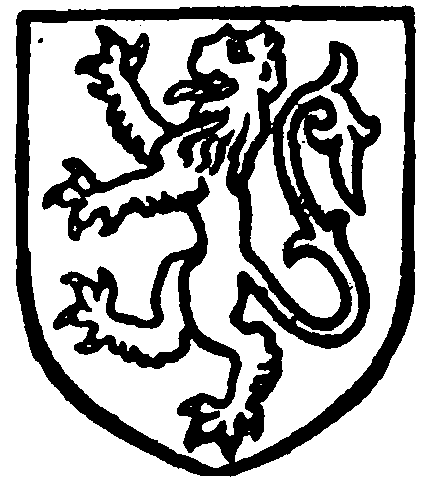
Redvers, Earl of Devon. Or a lion azure.
The manor descended in the same way as the lordship of the Isle of Wight to the Earls of Devon. (fn. 213) It was given by Amice Countess of Devon to the priory founded by Baldwin and Hugh de Redvers at Breamore, but in 1267–8 the prior released all his right in the manors of Langley and Rumbridge to Isabel Countess of Albemarle. (fn. 214) She must, however, have restored it to the prior, who was holding it in 1280. (fn. 215) The overlordship remained annexed to the honour of Carisbrook. (fn. 216) The Priors of Breamore retained the manor until the dissolution of their house in 1536, (fn. 217) when it was granted to Henry Marquess of Exeter. (fn. 218) He forfeited all his estates in 1538–9, and this manor was granted to Anne of Cleves in 1540. (fn. 219) She was divorced in the same year and the manor returned to the Crown, but was granted in 1545 to John Mill and his son George. (fn. 220) From that time the descent of the manor is identical with that of Nursling Prior (fn. 221) in Buddlesgate Hundred (q.v.).
A second manor of LANGLEY, which is mentioned for the first time in 1664, (fn. 222) passed with the manor of Colbury during the 17th and 18th centuries. (fn. 223) It is now probably merged in the other estate at Langley.
The manor of MARCHWOOD (Mercewode, xi cent.; Merchewude, xiii cent.; Marchewood Rumsey, xvi cent.) was held before the Conquest by Ulviet and at the time of the Domesday Survey by his son Alwin. (fn. 224) A rent of six quarters of salt in March wood passed during the 13th and 14th centuries with the manor of West Tytherley (fn. 225) (q.v.), but the manor of Marchwood, known also as Marchwood Romsey, belonged to the Romseys, who had also acquired the rent of salt before 1403–4. (fn. 226)
The manor of Marchwood Romsey was held of the Abbess of Romsey by fealty. (fn. 227) In 1599 it was said to be held of the Crown, as of the hundred of Redbridge. (fn. 228) John de Romsey held the vill of Marchwood in 1316, (fn. 229) and settled a messuage and 2 carucates of land in Marchwood, North Langley and Testwood upon himself and his wife Maud in 1335–6. (fn. 230) He was succeeded by Sir Walter Romsey of Rockbourne, who died in 1403–4 holding land in Marchwood. (fn. 231) The manor then passed in the same way as Romsey Horseys (q.v.) until the death of Thomas Horsey in 1477. (fn. 232) His brother and successor John Horsey seems to have subinfeudated the manor to John Romsey of Tatchbury, for he died in 1494 holding it of—Horsey, (fn. 233) and was succeeded by his son John, who died in 1503 holding it of John Horsey. (fn. 234) William Romsey, son and successor of this John, sold the manor to Henry White, who left it by his will dated 12 September 1534 to his executors for sixteen years for the maintenance of his children, with remainder to his sons Robert, Francis and Alban, and to his nephews Thomas and Henry White in tail-male. (fn. 235) The manor passed from Robert White to his son William in 1564–5, (fn. 236) and William and his wife Margaret conveyed it in 1579 to Richard Beconsawe. (fn. 237) This conveyance was probably in the nature of a mortgage, for in 1587 William White sold the manor to Nicholas Venables, and a warranty against Richard and William Beconsawe is inserted in the conveyance. (fn. 238) William Rickman died seised of the manor in 1599, leaving his daughter Katherine wife of David Urry his heir. (fn. 239) A hundred years later David Urry, described as of St. James', Westminster, sold the manor to Gilbert Serle of Leghorn, (fn. 240) and it subsequently passed in the same way as Weston Corbett (q.v.) to Sir William Oglander. (fn. 241)
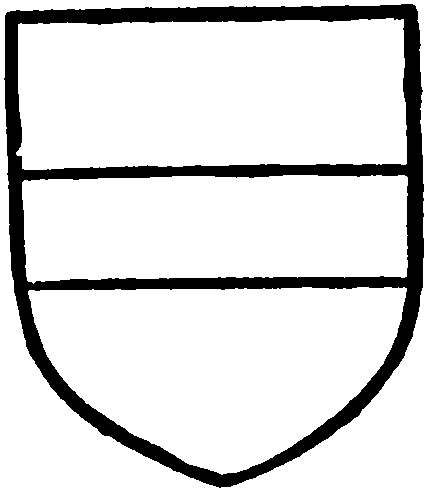
Romsey. Argent a fesse gules.
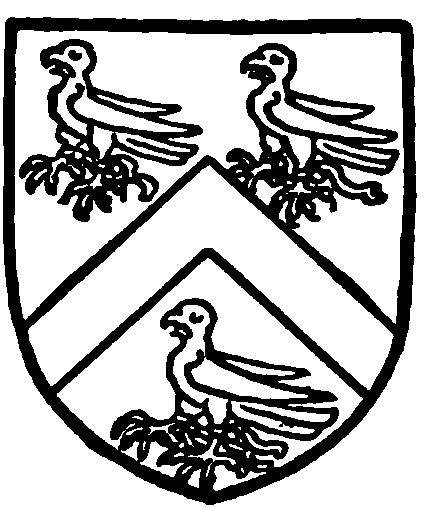
Urry. Gules a cheveron between three falcons argent.
The manor afterwards passed to John Saunders, of Downs House, on whose death in 1832 it descended to his son, Andrew Saunders. (fn. 242) Cecil Roy Saunders, who succeeded his father Andrew in 1876, died in 1907, and his brother, Archibald Carmichael Saunders, is now lord of the manor of Marchwood.
In 1489 Sir Richard Darell died seised of a messuage called WADE (La Waude, xiii cent.) and lands in Romsey and Eling held of Lord De La Warr, (fn. 243) and of forty messuages in Romsey held of the Abbess of Rom sey. (fn. 244) The subsequent descent of the manor is identical with that of Paultons or Ower (fn. 245) (q.v.) until the sale of Paultons by William Paulet in 1646. Wade was retained and sold in 1660 as the manor of Wade and Ower to James Betts of London. (fn. 246)

Saunders. Sable a cheveron ermine between three bulls' heads caboshed argent.
Wade Hill Farm was purchased in 1818 from William Young of Moorcourt by Lord Palmerston, who also purchased Wade Park Farm in 1857 from Mr. John Sydney Atkins. In 1859 the estate, which is known as the manor of Wade and Ower, passed by exchange to Winchester College, in whose possession it still is. (fn. 247) There was in 1607 'an ordinarie house of name "Wade," (fn. 248) presumably the manor-house, possibly now represented by the farm-house.
The manor of WIGLEY (Wiggeleia, Wigelay, xii cent.; Wygelee, xiii cent.) apparently belonged to the priory of Amesbury from early times. (fn. 249) In 1198–9 the Prioress of Amesbury granted half a hide of land at Wigley to Walter Long. (fn. 250) King John granted that the nuns of Fontevrault who were established at Amesbury should not be held accountable for damage done by their cart-wheels in the woods of Wallop and Wigley on their daily journey for the collection of fuel. (fn. 251) In 1286 a grant of free warren at Wigley was made to the Prioress and nuns of Amesbury. (fn. 252)
The manor, which was apparently sometimes known as the manor of Eling, (fn. 253) remained in the possession of the convent until the Dissolution (fn. 254) and was granted in 1545 to Edmund Vaughan, (fn. 255) who sold it in the same year to Richard Mill. (fn. 256) Richard (fn. 257) sold the manor in 1547 to Sir Francis Fleming, (fn. 258) who settled it in 1551 upon himself, his wife Joan and their heirs. (fn. 259) He sold it, however, in 1554 to John Dowce, (fn. 260) who was succeeded in 1558 by his son Richard, (fn. 261) of whom the manor was purchased in 1588 by William Paulet. (fn. 262) William died seised of it in 1596, leaving William his son and heir. (fn. 263)
The manor from that time followed the same descent as Paultons (fn. 264) (q.v.), which seems to have become the capital messuage of Wigley Manor before 1646. (fn. 265)
The manor of SHELVELEY (Seveleia, Saveleia, Selvelega, xii cent.; Shulvelegh, Shulvele, xiv cent.) was held of the Prioress of Amesbury for a rent of 18s. yearly. (fn. 266) This estate was probably acquired by the nuns of Amesbury at the same time and in the same way as Wigley, with which it was closely connected. Alured de Shelveley is mentioned in 1166–7 and in 1168–9, (fn. 267) and the mill of Shelveley is mentioned in the Pipe Rolls from 1170 to 1177. (fn. 268)
Thomas de Shelveley in 1294–5 granted a messuage, a mill and half a carucate of land in Shelveley and Wigley to Nicholas de Pershute and his wife Maud. (fn. 269) It then passed with the manor of Spurshot in Romsey to Nicholas de Pershute. (fn. 270) It is uncertain whether it passed from him on his death in 1369–70 to his son William, (fn. 271) or whether it had passed out of the possession of the family before that time. It is next mentioned in 1473, when Margaret Erneley died seised of it. (fn. 272) Her son and successor Edmund died in 1485 and was succeeded by his son John, (fn. 273) who in 1513–14 conveyed the manor to George Baron and Thomas Coke. (fn. 274) After this date the estate seems to have lapsed to the overlord, the Prioress of Amesbury. Rent from customary tenants at Shelveley was included among the possessions of the priory at the Dissolution, (fn. 275) and was probably included in land at Shelveley which was granted with the manor of Wigley to Edmund Vaughan in 1545. (fn. 276) It seems co have become incorporated with Wigley, which is described during the 16th, 17th and 18th centuries as extending into Shelveley. (fn. 277) Shelly Farm and Shelly Common to the north of Paultons Park still form part of Wigley Manor. (fn. 278)
An estate at CADNAM (Cadenham, xiii cent.; Cadham, xvii cent.) and WINSOR (Windelesore, Winderoures, xiii cent.; Windsor, xvi cent.) belonged to the nuns of Amesbury, who in 1286 obtained a grant of free warren in both estates. (fn. 279) They seem to have formed part of the manor of Wigley (q.v.) and rent of customary tenants at Cadnam was paid to the abbey until the Dissolution. (fn. 280) The property was probably included in land at Cadnam and Winsor granted with the manor of Wigley to Edmund Vaughan in 1545, (fn. 281) and apparently followed the same descent as Wigley (fn. 282) (q.v.)
The Abbot of Netley held an estate at WINSOR, and was summoned in 1280 to show why he should not allow his tenants there to do suit at the hundred of Redbridge. (fn. 283) In 1255–6 it was said that he had ceased to do suit at the hundred court of Redbridge for the 'soke' of Winsor, (fn. 284) and in 1419–20 a charter was produced at the abbot's court of Totton relating to a grant by a former abbot of a tenement in the vill of Winsor. (fn. 285) This estate evidently formed a part of the abbot's estate at Totton, (fn. 286) and passed with it to the Paulets, probably becoming incorporated with the other estate at Winsor held by that family.
Another manor of WINSOR was annexed to the capital manor of Eling, but is not mentioned until 1372–3, when the reversion of it after the death of Sir Hugh Camoys was conveyed by Sir Henry Husee to William of Wykeham, Bishop of Winchester. (fn. 287) The bishop granted it in 1385 with the manor of Eling to Winchester College, (fn. 288) and no further mention of it has been found.
In the time of Henry III Adam de St. Manufeuto made an encroachment of a quarter of an acre upon the highway at BERKLEY. (fn. 289) Berkley followed the descent of Minstead (q.v.), and is now held with the second manor of Totton by Mr. H. F. Compton. (fn. 290)
At the time of the Domesday Survey there were two mills and a fishery in the king's manor of Eling, (fn. 291) a fifth of a mill belonged to Agemund's holding at Totton, (fn. 292) and there was a mill in the Abbess of Romsey's manor of 'Dodintune.' (fn. 293) The mill of Shelveley is mentioned in the Pipe Rolls from 1170 to 1174, (fn. 294) and a mill and half a carucate of land at Shelveley and Wigley were granted by Thomas de Shelveley to Nicholas de Pershute and Maud his wife in 1294–5. (fn. 295)
There were two water-mills and a fishery in the manor of Testwood in 1380, (fn. 296) and it was stated in 1504–5 that Thomas West Lord De La Warr had in 1478 demised to Thomas Avan for forty years a certain water-mill, parcel of the manor of Testwood, together with the water-course leading towards the said mill from a place called 'le Wyldewater,' with all the creeks and fisheries. (fn. 297)
In 1268 the king confirmed a charter of Stephen Fitz Arard to the abbey of Romsey, by which Stephen gave to the abbey a fourth part of a mill at Totton with a virgate of land at 'Ryse,' when his daughter became a nun at Romsey. (fn. 298)
The flour-mill known as Eling Mill stands on Bartley Water. Testwood Mill is on the River Test opposite Testwood House, and its salmon fishery is still noted.
Churches
The church of ST. MARY THE VIRGIN, Eling, consists of a chancel, (fn. 299) north chapel of the same length, north vestry, a south chapel, a nave, north aisle, south aisle, north-west tower and south and west porches. The earliest church of which traces remain was perhaps of the 11th century, with chancel and nave of the same size as those now standing, and a small north transept with an eastern chapel or apse. At the end of the 12th century a south aisle was added to the nave, and early in the 13 th a north-west chapel to the chancel, replacing whatever building stood to the east of the transept. Shortly afterwards a north aisle of two bays was added to the nave, west of the transept, and late in the 13th century the chancel arch was rebuilt and made as wide as possible. In the 14th century a south chapel equal in length to the chancel was built, and in the 15th the north-west tower was added, taking up the west bay of the north aisle. The north transept was thrown into the aisle, an arch in continuation of the north arcade taking the place of its south wall, in which there was doubtless a narrow arch. In modern times the north chapel has been rebuilt and lengthened eastwards to equal the chancel, a north-east vestry added, the south aisle widened and the two porches built. Unfortunately the whole church has also been scraped and retooled.
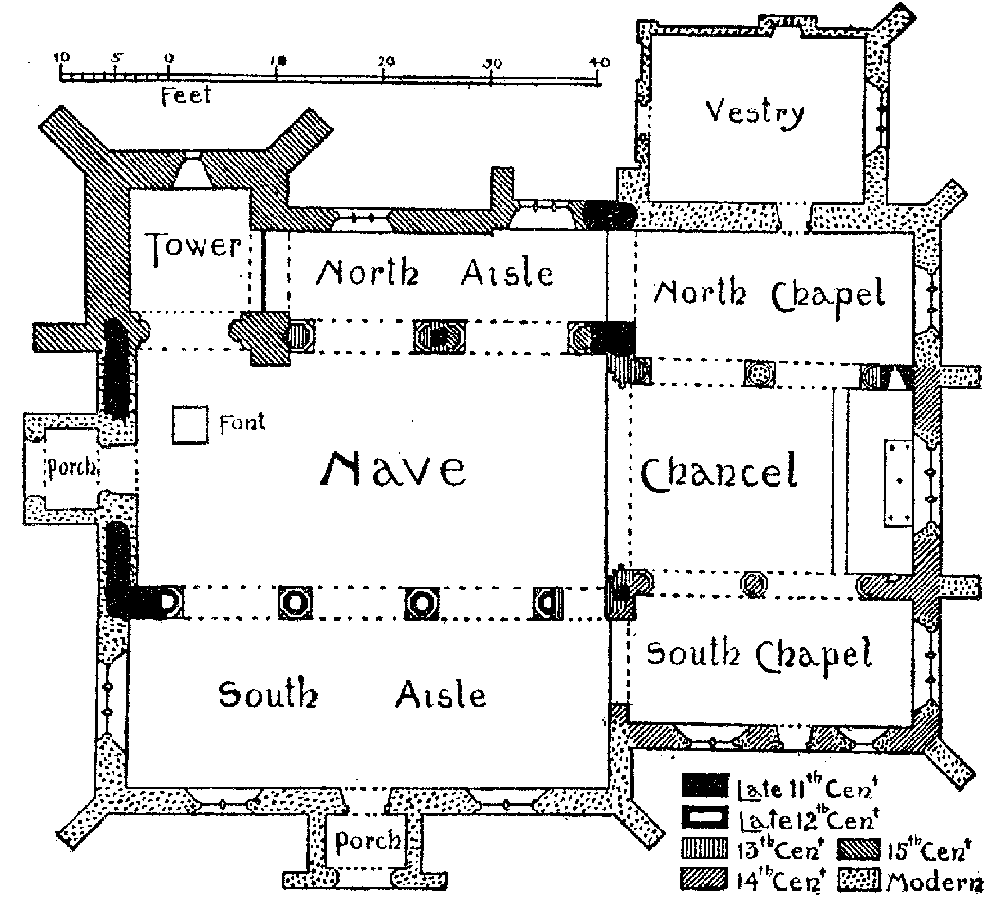
Plan of Eling Church
The three-light east window of the chancel is modern with tracery of 14th-century style. At the east end of the north wall is a square locker with a modern head. Above it is a narrow round-headed window with a wide internal splay. The head is made up of a number of very small voussoirs, and the jambs are each of a single slab squared on both edges. The whole has a very early look, and can hardly be later than the end of the 11th century, but its position close to the east wall of the chancel is most unlikely to be the original one. A suggestion has been made that an apse formerly stood to the east of the chancel, but there seems no evidence for this. To the west of this window is an arcade, originally of one bay, but in modern times increased to two, the eastern being modern, with the 13th-century respond reused. The arches are two-centred, of two chamfered orders, and the new central column is copied-from the responds, which are semicircular with moulded capital and bases. At the south-east of the chancel is a small trefoiled piscina, probably of the 16th century, with a rounded back to the recess, and a projecting bowl. In the south wail is an early 14th-century Purbeck stone arcade of two bays with two-centred arches of two chamfered orders, an octagonal column and semi-octagonal responds with moulded capital and bases, a good deal retooled. The chancel arch is an insertion of the late 13th century, of the full width of the chancel, but with splayed and shafted jambs towards the nave. It is two-centred, of three moulded orders on the west, carried on circular engaged shafts with moulded capitals and bases; the outer order is stilted at the springing.
The nave arcade is of three bays, not continuous on the north, where the east bay has a very acute two-centred arch of two chamfered orders with halfoctagonal responds and moulded capitals, and is of the 15th century, separated by a pier from the rest of the arcade. Of the two 13th-century western bays only the eastern arch and the spring of the western remain, the rest having been destroyed at the building of the tower. The arch is of two chamfered orders and rather obtuse two-centred form, with a roll label towards the nave, and the pillar is octagonal with moulded capitals and base, the latter having angle spurs. Immediately west of this a square projecting buttress to the east tower arch breaks into the line of the arcade, and in the western bay of the nave is the south tower arch, four-centred, of two moulded orders, the outer continuous and the inner carried on semi-octagonal responds with moulded capitals and bases. At the south-east of the nave is a small modern pointed arch pierced through the long abutment of the east respond of the arcade, and above it is the head of a small trefoiled niche on the level of the rood loft; the position is exceedingly unusual for a piscina, but not absolutely unexampled, and there is no reason why in particular circumstances an altar should not have been placed in the rood loft. The south arcade is continuous, with arches like the middle one on the north but without a label. The columns are octagonal with capitals of late 12th-century character and bases with spurs, some of them of most curious form, but both the capitals and bases have been practically recut. Over the west respond and only visible in the aisle is a very small round-headed opening, formed of a pierced slab of stone with a continuous roll worked on it; it looks like the slab from a double-splayed pre-Conquest window, and if it has an inner splay there is nothing to show it. The three-light west window is modern. The west door and its porch are also modern, of 14th-century design.
The east window of the north chapel is of the 16th century and has three cinquefoiled lights under a fourcentred head. It was repaired and reset when the chapel was lengthened. On the north is a modern door to the vestry. The western arch originally led to the transept and is semicircular with one slightly chamfered order springing from the wall on the north with a very rough chamfered abacus. The respond to the south has a modern abacus.
The south chapel appears to have been almost completely rebuilt, but without alteration to its plan. The windows are all modern, and consist of an east window of three lights, one of a single light and one of two lights on the south, with a modern door between them. On the west is an arch to the aisle, a plain round-headed opening set in a very thin wall; its date is doubtful, but probably not very remote.
The north aisle has two 15th-century square-headed windows of three lights. Between them is a break in the wall which represents the extent of the early transept, to the west of which the aisle is reduced in width by about 6 in. At the west is the tower arch, of the same date and detail as that to the south, but with flat responds into which the two orders die, and without capitals or bases.
The whole of the south aisle and the south porch together with their doors and windows are modern, with the exception of part of the east wall containing the transept arch. On the south are two two-light windows and between them a pointed door. The west window is of three lights with tracery. The south porch has an entrance of two chamfered orders and east and west windows of two small pointed lights.
The tower is of late 15th-century date in three low stages with an embattled parapet. The belfry openings were originally of two rounded uncusped lights with square-headed reveals. That to the west has been mutilated and one of the lights to the north has been bricked up. Set in the first string-course is a small pointed window of two chamfered orders, the string being broken over it to form a square outer head. In the ground stage to the north is a single cinquefoiled light. The tower has diagonal buttresses to the north-east and north-west and a square one to the south-west.
The vestry is a modern brick building with a 17th-century three-light transomed window reset in the east wall and an external door to the west, over which is set a carved stone head or 14th-century character. The font is modern. The nave roof is old but of uncertain date, quite plain and of open collar construction, and that of the north aisle is a plain lean-to roof, probably of 16th-century date.
In the north chapel is a brass with an inscription to William Paulet, 1596, 'nobili et illustri Pauletorum de Basing Familia,' and his wife Dulcebella Paget, by whom he had five sons and three daughters. Three shields display: (1) Paulet, three swords in pile, a crescent with a molet thereon for difference, impaling Argent a cheveron vair between three talbots sable; (2) nine quarters: Paulet quartering Roos of Gedney, Poynings, St. John, Delamere, Hussey, Skelton, Irby and Delamore; (3) as (1). A white marble wall monument to Richard Paulet of Gray's Inn, 1737, and another to Susanna Serle, 1755, with a very good bust by Rysbrach, are also in the north chapel. Another monument by Rysbrach is at the north-east of the nave, to Elizabeth Serle, 1741. In the north aisle is a light grey marble monument to Gilbert Serle, 1720. The heraldry is illegible except the crest, a burning tower. Near it is a funeral helm with the same crest carved in wood. The helm is supported on a wrought-iron bracket which has a haming bar for a tabard. The tabard, however, has been quite recently taken down and thrown away. At the south-east of the chancel is an early 17th-century monument to Catherine wife of John Mill and daughter of Sir Roger Lewknor of Sussex, and to her son Lewknor Mill, who married Cicely Crooke and had four sons and three daughters. No dates are given.
In the churchyard are a number of very good carved 18th-century headstones, well worthy of careful study as specimens of a local art, all cut in the hard Purbeck stone. One of the best is to Thomas Warwick, 1764, with a ship sailing round the world, and a very curious one is to another mariner, George Bartley, 1765, with portraits of himself, his wife and his ship, his sons and daughters, and the instruments of his profession, sextant, compass, rule, &c. A better example of the same type is in Dibden churchyard.
The church possesses a Last Supper of the Venetian school, c. 1520–unfortunately a great deal restored; it was formerly used as an altar-piece.
The bells are six in number, recast by Pack & Chapman in 1775.
The plate is a fine silver-gilt service consisting of chalice, paten cover, paten and flagon of 1693, given in that year by or in memory of Margaret Leigh, one of the Leighs of Coldrey (Hants), and an alms dish of 1707.
The registers are in teven books: (1) all entries, 1537 to 1673; (2) the same, 1673 to 1750; (3) baptisms and burials, 1750 to 1796; (4) baptisms and burials, 1796 to 1802; (5) baptisms and burials, 1802 to 1812; (6) marriages, 1754 to 1778; and (7) marriages, 1778 to 1812.
The church of ST. MARY, Copythorne, is of brick in debased 'Gothic' style, consisting of chancel, nave, south aisle, north porch and embattled western tower.
CHRIST CHURCH, Colbury, is of flint and stone in 13th-century style, consisting of chancel, nave, north porch and bell-turret.
The church of ST. JOHN, Marchwood, is of brick and stone in 15th-century style, consisting of chancel, nave, south aisle, transepts and a tower with spire.
The church of ST. MATTHEW, Netley Marsh, is of stone in 13th-century style, consisting of chancel, nave, aisles, south porch and bell-turret.
Advowson
There was a church at Eling at the time of the Domesday Survey, to which belonged half a carucate of land. (fn. 300) The advowson remained in the kings of England until it was granted with the manor by Richard I to Gervaise de Southampton, (fn. 301) who gave it to his brother Roger. (fn. 302) In 1198–9 a plea took place between Ralph de Hamton on behalf of his father and Robert Bertram as to the church of Eling. (fn. 303) The advowson apparently returned to the Crown on the death of Gervaise, and was granted by King John in 1204–5 to the Prior and canons of Mottisfont. (fn. 304) The advowson remained in the possession of successive priors until the Dissolution, (fn. 305) when it passed to the Crown. It was granted in 1536 to William Sandys Lord Sandys, (fn. 306) and passed with the title of Lord Sandys until 1667, (fn. 307) when the presentation was made by Lord Sandys for the last time. (fn. 308) John Speed, M.D., presented in 1689, (fn. 309) and dying in 1711 was succeeded by his son Dr. John Speed, from whom the advowson passed in 1747 to his son, a third Dr. John Speed. (fn. 310) His son and successor, the Rev. John Mylles Speed, died without issue in 1792, (fn. 311) and his widow Harriet presented to the living in that year. (fn. 312) The Rev. Charles Sloman presented in 1797 (fn. 313) and William Phillips in 1802. (fn. 314) The advowson remained in the Phillips family until 1897–8, when it passed from William Phillips to Mr. J. E. Ward, the present patron. (fn. 315)
North Eling was formed into an ecclesiastical parish from Eling in 1837. (fn. 316) The living is a vicarage in the gift of the trustees of the Rev. W. J. G. Phillips.
Colbury was formed into an ecclesiastical parish from Eling in 1872, (fn. 317) and comprises Colbury and Longdown. The living is a vicarage in the gift of Mrs. Vaudrey Barker-Mill, the daughter of Frederick Ibbotson, the founder of the benefice.
Marchwood became a separate ecclesiastical parish in 1843. (fn. 318) The church was built and endowed by Horatio Francis Kingsford Holloway in 1843, (fn. 319) and the advowson remained in the possession of his family until 1887–8, when it passed to Charles Bartholomew, (fn. 320) in whose trustees it is now vested.
Netley Marsh became an ecclesiastical parish in 1855. (fn. 321) The church was built in 1854–5 chiefly at the expense of Miss Ann Sturges Bourne, of Testwood House, who endowed the vicarage. (fn. 322) The advowson was in her possession until 1892, when it passed to the vicar of Eling, (fn. 323) in whom it is now vested.
There is at Totton a chapel of ease to the parish church of Eling, dedicated to St. Mary.
In 1672 the house of Esther Oviet at Eling was licensed for Presbyterian worship. (fn. 324) The Congregational chapel at Cadnam was founded in 1790, that at Totton in 1811, and that at Netley Marsh in 1901. (fn. 325) There are also a Congregational chapel at Marchwood, Primitive Methodist chapels at Totton and Cadnam, a Baptist chapel at Bartley, and a Gospel mission hall at Totton, erected in 1901.
Charities
The parliamentary returns of 1786 state that a house, then vested in the churchwardens, had been given to the poor by a Mrs. Moody. It was used as almshouses for four widows until 1860, when the houses were burnt down.
